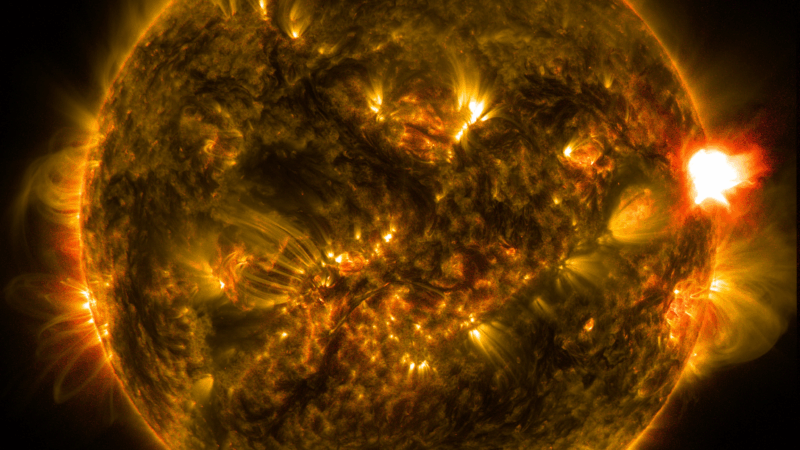Why solar flares are way hotter than researchers thought
Beautiful yet dangerous solar flares that erupt from the sun could be as hot as 180 million degrees Fahrenheit, researchers say.
That’s more than six times hotter than solar physicists previously believed, according to a new report in Astrophysical Journal Letters.
Alexander Russell, a physicist with the University of St. Andrews in Scotland, called that temperature “a crazy number” that he and his colleagues found “incredible.”
Solar flares occur when magnetic energy gets suddenly released and dumped into particles. These particles, ions and electrons, get heated up and shoot out at great speed.
Previously, researchers used telescopes to measure the temperature of electrons in solar flares. “And we’ve kind of just assumed, well, the ion temperature would be the same as the electron temperature,” says Russell.
But recent computer simulations and measurements in near-Earth space suggest that this assumption is wrong: They show that ions heat up way more.
Russell and his colleagues did some calculations and found that solar flares could actually be over 100 million degrees Fahrenheit, and quite possibly hotter.
James Drake, a physicist at the University of Maryland who wasn’t part of this research team, has been studying how magnetic processes heat and speed up electrons and ions for some time. He says until now, the difference between the two has been overlooked when it comes to solar flares.
“We’ve been confronting the solar physicists,” says Drake, “telling them that even though they’ve measured in a lot of detail what’s going on with the electrons, they’re missing something big.”
That’s why he says he was happy to see this new analysis, as it could lead to a better understanding of how solar flares work. And that in turn could help protect hardware like satellites and people like astronauts from these dangerous but awesome eruptions.
“We’re already busy on the next steps,” says Russell, who says they’re developing models of how flares evolve when the ions are heated more strongly than the electrons.
Russia sends 3 Iranian satellites into orbit, report says
The report said that a Russian rocket sent the satellites on Sunday from a launchpad in eastern Russia.
Viral global TikToks: A twist on soccer, Tanzania’s Charlie Chaplin, hope in Gaza
TikToks are everywhere (well, except countries like Australia and India, where they've been banned.) We talk to the creators of some of the year's most popular reels from the Global South.
This painting is missing. Do you have it?
An important work from a rediscovered artist has been absent from public view since the 1970s. A New York curator is hunting for it.
Memory loss: As AI gobbles up chips, prices for devices may rise
Demand for memory chips currently exceeds supply and there's very little chance of that changing any time soon. More chips for AI means less available for other products such as computers and phones and that could drive up those prices too.
Brigitte Bardot, sex goddess of cinema, has died
Legendary screen siren and animal rights activist Brigitte Bardot has died at age 91. The alluring former model starred in numerous movies, often playing the highly sexualized love interest.
For Ukrainians, a nuclear missile museum is a bitter reminder of what the country gave up
The Museum of Strategic Missile Forces tells the story of how Ukraine dismantled its nuclear weapons arsenal after independence in 1991. Today many Ukrainians believe that decision to give up nukes was a mistake.









